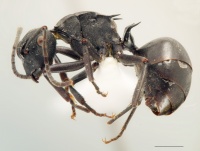Polyrhachis clarki
| Polyrhachis clarki | |
|---|---|
| Scientific classification | |
| Kingdom: | Animalia |
| Phylum: | Arthropoda |
| Class: | Insecta |
| Order: | Hymenoptera |
| Family: | Formicidae |
| Subfamily: | Formicinae |
| Tribe: | Camponotini |
| Genus: | Polyrhachis |
| Subgenus: | Hagiomyrma |
| Species group: | penelope |
| Species: | P. clarki |
| Binomial name | |
| Polyrhachis clarki Kohout, 2013 | |
The type series are the only specimens known of P. clarki.
Identification
A member of the penelope species-group in the Polyrhachis subgenus Hagiomyrma. Polyrhachis clarki is distinguished from other Hagiomyrma species by the lack of hairs on the dorsum of the body, the rather short, very slender, downturned and outwardly directed propodeal spines and the strongly upturned petiolar spines with a deeply concave dorsum between their bases. There is some variation in the form of the pronotal humeri which are either subacute (as in the holotype and some paratypes) or narrowly rounded (in the remaining paratypes).
Keys including this Species
Distribution
Distribution based on Regional Taxon Lists
Australasian Region: Australia (type locality).
Distribution based on AntMaps
Distribution based on AntWeb specimens
Check data from AntWeb
Countries Occupied
| Number of countries occupied by this species based on AntWiki Regional Taxon Lists. In general, fewer countries occupied indicates a narrower range, while more countries indicates a more widespread species. |

|
Estimated Abundance
| Relative abundance based on number of AntMaps records per species (this species within the purple bar). Fewer records (to the left) indicates a less abundant/encountered species while more records (to the right) indicates more abundant/encountered species. |

|
Biology
Castes
Known only from the worker caste.
Nomenclature
The following information is derived from Barry Bolton's Online Catalogue of the Ants of the World.
- clarki. Polyrhachis (Hagiomyrma) clarki Kohout, 2013: 533, figs. 6E-F (w.) AUSTRALIA.
Unless otherwise noted the text for the remainder of this section is reported from the publication that includes the original description.
Description
Worker
(Holotype cited first): TL c. 7.31, 7.31-7.91; HL 1.78, 1.78- 1.93; HW 1.47, 1.47-1.59; CI 82, 81-85; SL 1.96, 1.93-2.18; SI 133, 131-140; PW 1.25, 1.22-1.31; MW 0.72, 0.72-0.81; PMI 174, 162-174; MTL 2.18, 2.15-2.43 (6 measured).
Mandibles with 5 teeth, outer tooth distinctly short and blunt. Anterior clypeal margin with denticulate flange medially, flanked by acute teeth. Clypeus with distinctly raised median carina, shallowly sinuate in profile (almost straight in some specimens); basal margin virtually flat. Frontal triangle distinct. Frontal carinae sinuate with weakly raised margins; central area relatively wide, raised medially with rather short frontal furrow. Sides of head in front of eyes weakly convex, rounding into mandibular bases; behind eyes, sides rounding into convex occipital border. Eyes convex, exceeding lateral cephalic outline. Ocelli lacking. Pronotal humeri subacute or narrowly rounded in some specimens, margins weakly raised; pronotal dorsum widest at midlength. Pronotal and mesonotal dorsa with lateral margins convering posteriorly; metanotal groove indistinct medially. Propodeal dorsum with margins weakly divergent posteriorly, terminating in slender, acute, divergent, downturned spines. Petiole with anterior face straight, posterior face weakly convex; dorsum deeply concave medially, armed laterally with pair of distinctly elevated, divergent, acute spines. Anterior face of first gastral tergite widely rounding onto dorsum.
Mandibles distinctly longitudinally striate with numerous piliferous pits. Head and mesosoma very finely and closely reticulate-punctate with sculpturation on sides of head and mesosoma somewhat more distinct. Gaster finely shagreened.
Mandibles with several medium length, golden hairs at masticatory borders, distinctly shorter and closely appressed hairs towards mandibular bases. Only a few anteriorly directed setae fringing anterior clypeal margin. Fore coxae and gastral venter and apex with medium length, semierect, golden hairs. Whole dorsum of body, including head, mesosoma, petiole and gaster without hairs, except a few, short hairs on apical gastral tergites. Closely appressed, silvery pubescence sporadically scattered on venter of head, propodeal declivity, venter and sides of gaster; pubesence completely lacking over most dorsal body surfaces, including gaster.
Black; mandibular masticatory borders, condylae and subpetiolar process medium reddish-brown; antennae and tarsi dark reddish-brown.
Type Material
- Holotype, worker, Geraldton, Australia, J. Clark, Museum Victoria, Melbourne.
- Paratype, 8 workers, Geraldton, Australia, J. Clark, Museum Victoria, Melbourne.
- Paratype, 1 worker, Geraldton, Australia, J. Clark, Australian National Insect Collection.
- Paratype, 1 worker, Geraldton, Australia, J. Clark, The Natural History Museum.
- Paratype, 1 worker, Geraldton, Australia, J. Clark, Museum of Comparative Zoology.
- Paratype, 1 worker, Geraldton, Australia, J. Clark, Queensland Museum.
Apart from the holotype, which is in relatively good condition, most of the types are poorly preserved with various legs, antenae and/or gasters missing.
Etymology
Named in honour of the collector, the late John Clark, former entomologist at the Museum of Victoria, Melbourne.
References
- Heterick, B.E. 2021. A guide to the ants of Western Australia. Part I: Systematics. Records of the Western Australian Museum, Supplement 86, 1-245 (doi:10.18195/issn.0313-122x.86.2021.001-245).
- Heterick, B.E. 2022. A guide to the ants of Western Australia. Part II: Distribution and biology. Records of the Western Australian Museum, supplement 86: 247-510 (doi:10.18195/issn.0313-122x.86.2022.247-510).
- Kohout, R.J. 2013. Revision of Polyrhachis (Hagiomyrma) Wheeler, 1911 (Insecta: Hymenoptera: Formicidae: Formicinae). Memoirs of the Queensland Museum, Nature 56, 487-577.

